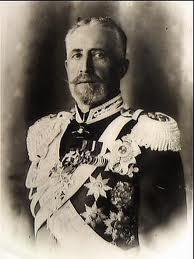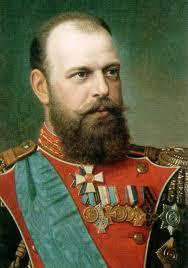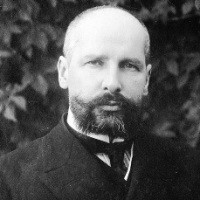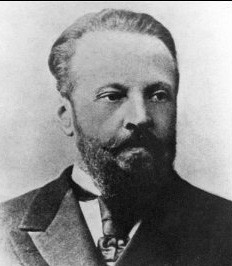Alexander III (1845-1894) was the father of Nicholas II and the second-last Romanov tsar of Russia. The young Alexander grew to be the epitome of a strong autocratic tsar: he was loud, masculine, physically imposing and often short-tempered. He was also dismissive of liberal and reformist ideas – a perspective strengthened by the bloody assassination of his liberal-minded father, Alexander II, at the hands of populist revolutionaries. Alexander ascended to the throne in 1881 determined to crush revolutionary movements, to restore the iron grip of tsarist autocracy and to ‘make Russia Russian’. During his 13-year rule, he expanded and strengthened the secret police (Okhrana) and imposed Russian language, culture and religion on peoples across the empire. This policy of ‘Russification’ made him enormously unpopular – but he also had the advantage of being greatly feared, both by those he ruled and those in his inner circle. The tsar died in 1894 and the crown passed to his son, Nicholas, who Alexander had privately believed was unsuited for leadership.
Alexandra (1872-1918) was the Tsarina (queen consort) of imperial Russia during the reign of her husband, Nicholas II. Known to family members as Alix, she was born in the German state of Hesse, the daughter of the Hessian grand duke and a granddaughter, through her mother’s line, of Queen Victoria of Great Britain. She met Nicholas, her second cousin, in 1884 and they married a decade later. Unlike other royal unions of the time, Nicholas and Alexandra’s marriage was based on love and affection, rather than political expediency. It also required Alexandra to convert from Lutheranism to the Russian Orthodox faith, to which she grew devoted. Alexandra was a strong-willed, sometimes obstinate woman who exerted considerable influence over the tsar. She urged him to maintain the autocracy and impose his will over Russia while supporting and strengthening Nicholas’ own misguided beliefs. She is perhaps best known for her infatuation and devotedness to Grigori Rasputin, the Siberian faith healer whose political manipulation of the tsarina further discredited the tsarist regime. Alexandra was shot with the rest of her family in Ekaterinburg in July 1918. (See also Tsar Nicholas II)
Anton Denikin (1872-1947) was a general in the tsarist Imperial Army and, later, an important White commander during the Civil War. Like General Kornilov, who he supported, Denikin was born to peasant stock but rose through army ranks. In 1919 he led a failed attempt to recapture Moscow from the Bolsheviks – as well as instigating anti-Semitic pogroms and campaigns of ‘White Terror’ that claimed thousands of lives. He fled Russia in 1920 and spent the rest of his life in France and the United States.
Fyodor Dubasov (1845-1912) was a tsarist naval officer known for his violent suppression of urban and peasant uprisings. In 1905 Dubasov was appointed governor-general of Moscow, which was gripped by unrest and insurrection. Dubasov moved armed troops and artillery into the city and ordered them to fire on large mobs, killing hundreds. He became a hated figure and a target of assassins, who almost claimed his life in 1906.
Alexander Kolchak (1874-1920) was a Russian admiral, most notably the commander of the Tsar’s Black Sea Fleet during World War I. Kolchak later became the titular ‘supreme commander’ of the White Armies, though in reality, he was unable to coordinate their efforts. He was captured, tried and executed during the Russian Civil War.
Lavr Kornilov (1870-1918) was a leading general in the tsarist Imperial Army, best known for conspiring against the Kerensky government in August 1917. Born into a Cossack family in what is now Kazakhstan, Kornilov entered the military at age 15 and proved himself an excellent soldier, both on the battlefield and in positions of responsibility. He worked his way up through the ranks and by the outbreak of World War I was a major-general. Politically, Kornilov was conservative, nationalist and bitterly opposed to socialism. He lost faith in both the tsarist and Provisional Governments because both had shown themselves incapable of managing the war effort and crushing radicalism. In August 1917 Kornilov made arrangements to move troops into Petrograd to seize control and restore order in the capital; this imposition of martial law, he claimed, had been authorised by Kerensky. Kornilov was subsequently arrested and detained, before escaping and taking the helm of a White Army regiment in the first months of the Russian Civil War. He was killed by Bolshevik artillery in southern Russia.
Nicholas II (1868-1918) was the last tsar of Russia until he was forced to abdicate following the February Revolution. A member of the Romanov dynasty that had ruled Russia for more than three centuries, Nicholas was the son of Alexander III, though the two were not alike in either their physical presence or leadership. While Alexander III a was dominant, overbearing and intimidating ruler, the young Nicholas was short, softly-spoken and reserved. Though not unintelligent, Nicholas was deeply religious, anti-Semitic, political conservative and easily influenced by those around him, particularly his wife Alexandra. The young Nicholas received training as a cavalry officer, though his education in politics and matters of empire were neglected by his father. Still, when Nicholas came to the throne in 1894 he was determined to maintain the autocracy he had inherited. Imperial expansion was another of his aims, leading Nicholas to instigate the ill-fated war with Japan (1904-5) which caused domestic unrest at home and almost cost him his throne. But while the tsar promised political reform, he had learned little from the debacle of 1905 and he returned to policies of reaction and oppression. Like other European monarchs, Nicholas was drawn into World War I, where Russia’s lack of economic development and military modernisation were cruelly exposed. His decision to take personal command of the army (September 1915) had no disastrous effect on the war effort but it spelt the beginning of the end for his regime. In March 1917 Nicholas, with both politicians and generals against him, was forced to abdicate. He and his family were executed by Bolshevik partisans in Ekaterinburg some 16 months later. (See also Tsar Nicholas II)

Nicholas Nikolaevich (1856-1929) was a grand duke of the Russian nobility, a first cousin to Tsar Nicholas II and, until 1915, commander-in-chief of the Russian army. He entered the military as a teenager and within years had seen action in the Russo-Turkish War (1877-78). Later he became a military trainer and inspector, tough and authoritarian but fair enough to earn the respect of the men he commanded. According to an apocryphal legend, in 1905 Nikolaevich refused the tsar’s order to take command of the military and crush the growing rebellion. In 1914 Nikolaevich put in charge of Russian forces on the Western Front, despite having no experience at combat command. His leadership was not disastrous but nor was it talented or adaptive enough to overcome the enormous structural problems in the Russian army. In September 1915 the tsar replaced him as battlefield commander. Nikolaevich served out the way in safe postings. After the Bolshevik revolution, he fielded requested to join the White movement but continually resisted these overtures.
Vyacheslav von Plehve (1846-1904) was a tsarist minister and police chief who oversaw the expansion of the Okhrana in the 1880s. Loyal to tsarism, Plehve was the individual held most responsible for the brutal repression of revolutionary groups under Alexander III. He was assassinated in St Petersburg, a bomb hurled into his carriage by SR agents.
Konstantin Pobedonostsev (1827-1907) was an ultra-conservative Russian politician, an administrator of the Russian Orthodox Church and influential advisor to Alexander III. He was known for his hatred of democracy, his intense anti-Semitism and his enforcement of autocracy. He played an important role in shaping and reinforcing the traditionist views of the young Nicholas II.
Alexander Protopopov (1866-1918) was a conservative politician, a member of the Octobrist Party and a deputy in the third and fourth Dumas. A fervent supporter of the tsar and his autocracy, Protopopov was both a friend of Rasputin and a favourite of the Tsarina, who pushed for his appointment as interior minister in September 1916. He was arrested after the February Revolution and later executed by the Bolsheviks.
Grigori Rasputin (1869-1916) was a Siberian-born faith healer and starets (‘spiritual teacher’) who ingratiated himself with the royal family in the years prior to revolution. Rasputin journeyed to St Petersburg in 1905, probably to join the throng of occultists and spiritualists who ministered to the city’s aristocracy. Learning that the infant tsarevich Alexei was chronically ill, Rasputin arranged an appointment with his mother. Whether by persuasion, hypnotism or some other force, Rasputin managed to convince the tsarina of his ability to ease the boy’s suffering. The Romanovs supplied him with an apartment in the capital and he became a regular visitor to the Winter Palace. When not with the Romanovs, Rasputin was usually engaged in drunken parties or carousing with low-rent prostitutes. He also began to exert considerable political influence over Alexandra, particularly after the tsar had left for war in 1915. This interference discredited the Tsarina and the monarchy and led to the conspiracy that took Rasputin’s life in 1916. (See also Grigori Rasputin)
Alexei Romanov (1904-1918) was the only son of Nicholas II and Alexandra and the tsarevich (heir apparent) to the Russian throne. Alexei, a shy and humble boy, suffered from haemophilia, a genetic blood disorder he inherited from his mother. His painful bleeding episodes prompted his mother to seek the counsel of Rasputin. Alexei was shot by Bolshevik agents in Ekaterinburg, three weeks before his 14th birthday.
Petr Stolypin (1862-1911) was a Russian politician and minister who led the tsarist counter-revolution after 1905. Born to an aristocratic family, Stolypin received a university education, entered the public service and rose quickly through the ranks of the bureaucracy. By the age of 40 Stolypin was serving as a provincial governor, where he demonstrated a willingness to use the police and military to quell unrest and impose tsarist policies. In 1905 Stolypin became Minister for the Interior; months later the tsar appointed him chief minister. Stolypin responded to the 1905 Revolution by ordering the repression of militant workers and political groups; his actions increased government executions to such an extent that the hangman’s noose was dubbed ‘Stolypin’s necktie’. Stolypin also initiated land reforms and manipulated Russia’s electoral laws to dilute anti-tsarist dissent in the Duma. He was assassinated while attending the theatre in 1911; the motives of the assassin remain in dispute. (See also Tsarist reaction)
Sergei Witte (1849-1915) was a Russian politician prior to World War I, known mainly for his economic reforms and his liberal political views. Born to an affluent family in what is now Georgia, as a young man Witte worked in the tsarist bureaucracy, specialising in transport and railways, before moving into private industry. In 1892 Witte was recruited into Alexander III’s ministry and given responsibility for transport, communications and finance. He undertook several important economic reforms, including a state monopoly on vodka production, the construction of the Trans-Siberian Railway, the introduction of the gold standard and incentives to attract foreign investment in industrial projects. Witte’s changes facilitated the rapid expansion of Russia’s industrial sector, though they made him unpopular with the conservative elite. In 1905 Witte negotiated the treaty that concluded the Russo-Japanese War; he then advised the tsar to introduce liberal political reforms, including a constitution and an elected assembly. These recommendations resulted in the October Manifesto, a document Witte reportedly drafted. (See also Russian industrialisation)
© Alpha History 2018-23. Content on this page may not be republished or distributed without permission. For more information please refer to our Terms of Use.
This page was written by Jennifer Llewellyn, John Rae and Steve Thompson. To reference this page, use the following citation:
J. Llewellyn et al, “Russian Revolution who’s who – tsarists” at Alpha History, https://alphahistory.com/russianrevolution/russian-revolution-whos-who-tsarists/, 2018, accessed [date of last access].







